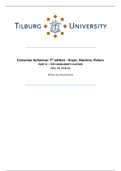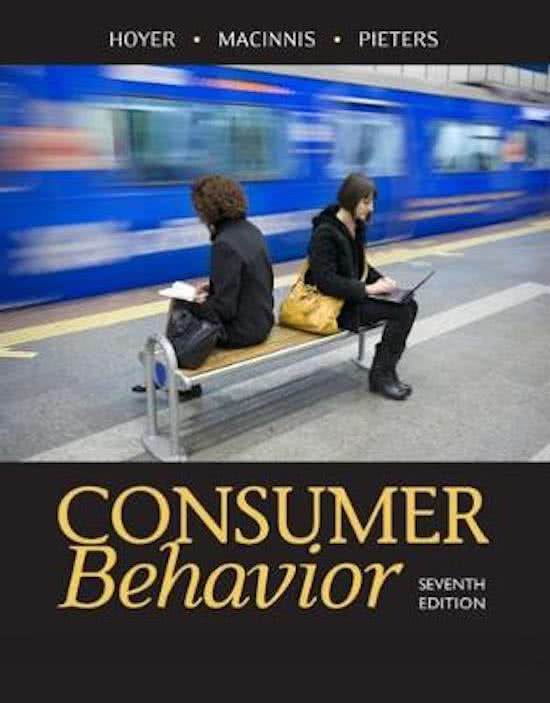Consumer behaviour 7th edition - Hoyer, Macinns, Pieters
PART IV – THE CONSUMER’S CULTURE
H11, 12, 13 & 14
Written by: Eva Lemmens
,Chapter 11) Social Influences on Consumer Behaviour
Sources of Influence
Building buzz can be effective because it uses the influence of third parties to amplify initial
marketing efforts.
- Rovio Entertainment teamed up with Britain’s Prince William to call attention to illegal
animal poaching of endangered species by promoting a special downloadable Angry Birds
game called ‘Roll with the Pangolin’. Involving Prince William boosted the level of buzz during
the game’s launch.
Marketing source: influence delivered from a marketing agent, for example, advertising, personal
selling.
- Marketing sources delivered via mass media
o Advertising, sales promotions, publicity, special events, and social media posts from
companies
- Marketing sources delivered personally
o Salespeople, service representatives, customer service agents
- Marketing sources delivered via social media
Nonmarketing source: influence delivered from an entity outside a marketing organization, for
example, friends, family, the media.
- Nonmarketing sources delivered via mass media
o News, critiques/reviews/blogs, program content, external endorsements, cultural
heroes, clubs/organizations, virtual communities
- Nonmarketing sources delivered personally
o Family, friends, neighbour, acquaintances, classmates, co-workers
o Word of mouth: verbally from one person to another person or group of people
this is more effective among people with weak ties
- Nonmarketing sources delivered via social media
How do these general sources differ?
- Reach: mass media delivered has higher reach (=bereiken meer mensen) than personally
delivered
- Capacity for two-way communication: personally delivered has higher capacity than mass
media delivered, because:
o Can be adapted to personal wishes
o When personally delivered people are less likely to avoid information inconsistent
with their own frames of reference.
- Credibility: marketing sources are seen as less credible, more biased and manipulative.
Nonmarketing sources have higher credibility, because we don’t believe that they have
personal stake in our purchase, consumption or disposal decisions.
Marketing implications:
Use a mix of sources to enhance impact, because marketing and non-marketing sources differ in
their impact, the effect will be greater when these are combined.
Opinion leader: an individual who acts as an information broker between the mass media and the
opinions and behaviours of an individual or group. Have some position, expertise, or first-hand
knowledge. non-marketing source. Do not need to be well-known people (can be acquaintances,
etc. as well). Part of a general category of gatekeepers.
Characteristics opinion leaders:
- Tend to learn a lot about products
, - Heavy users of mass media
- Tend to buy new products when they are first introduced
- Self-confident
- Gregarious (=houdend van gezelschap)
- Willing to share product information
They may become opinion leaders because of an intrinsic interest in and enjoyment of certain
products
Gatekeeper: a source that controls the flow of information. People who have special influence or
power in deciding whether a product or information will be disseminated (=verspreid) to a market
Market maven: a consumer on whom others rely for information about the marketplace in general.
Seems to know all about the best products, the good sales, and the best stores or retail websites.
Reference groups as sources of influence
Reference group: a set of people with whom individuals compare themselves for guidance in
developing their own attitudes, knowledge, and/or behaviours.
Types of reference groups:
- Aspirational reference group: a group that we admire and wish to be like but are not
currently a member of.
o A younger brother may want to be like his older brother and other older children
o Given the high respect accorded to education in South Korea, teachers often serve as
an aspirational reference group for students there.
- Associative reference group: a group to which we currently belong (clique of friends,
extended family, particular work group, club, school group). When consumers misunderstand
their relative position in a reference group, they tend to make poor acquisition or
consumption decisions.
o Brand community: a specialized group of consumers with a structured set of
relationships involving a particular brand, fellow customers of that brand, and
the product in use. Buy the product repeatedly and are extremely committed to it,
share their information and enthusiasm with other consumers and influence other
members to remain loyal.
▪ HOG (Harley Owners Group)
- Dissociative reference group: a group we do not want to emulate. Groups whose attitudes,
values, and behaviours we disapprove of and do not wish to emulate.
o US citizens serve as dissociative reference groups to religious groups in some Arab
countries
Characteristics of reference groups:
- Degree of contact.
o Primary reference group: with whom we have face-to-face interaction (family, peers,
professors)
o Secondary reference group: one that may influence us even though we have no
personal contact with most of its members (other members of a musical fan club, we
don’t interact with all members)
- Formality. Some groups are formally structured (=have rules, etc.): athletic teams, clubs.
Others are informally structured: group of friends, people who attend the same party
vacation
- Homophily: the similarity among the group-members. High homophily strong influence
- Group attractiveness: can affect how much consumers conform to the group
- Density: dense groups: all group members know one another (extend family)






